CHECKLIST OF BOSTON RETAILERS IN ARTIST'S MATERIALS: 1823–1887
Norman E. Muller
1 INTRODUCTION
In 1973 an article by this author, titled “Boston Canvas Stencils, Origin and Interpretation,” appeared in the Premier Issue of the American Art Review.2 That article did not include a list of the Retailers, and it is therefore being published here along with photographs of their stencils.
The idea for stenciling canvases seemingly originated in London in the 1790's when Thomas Brown, Thomas Poole, and Reeves and Sons opened shops.3 Canvases bearing their stamps were shipped to the United States and have occasionally been found on American paintings, one of the earliest being a Poole stencil on a painting by John Brewster (1766–1846).4 It was not until the 1830's, however, that the idea of stenciling canvases took root in the United States, principally in New York City.5 Thereafter, the idea spread, and by the 1840's most of the major eastern cities, such as Boston, had shops issuing these unique trademarks.
It will sometimes be observed that the stencils read “From” a particular retailer. This often means that the fabric was prepared by someone else and simply sold by a second party, who often impressed his own stencil. For example, canvases sold by J. J. Adams often bear two stencils: his own, which is headed by “From” as shown in Figure 1a, and the preparator, which in one instance was G. Rowney of London, shown in Figure 1b. In the latter case, the Rowney stencil was partially hidden by the stretcher member, which suggests that the prepared linen was probably shipped to Adams on a roll with the Rowney stencils imprinted at regular intervals. Cutting the roll to irregular sizes could account for the partial obscuring of the Rowney stencil. Similarly, the stencils of N. D. Cotton, shown in Figure 3, clearly state that the linen was prepared in England. As no English stencil was found on the one example discovered by the author, perhaps—and I emphasize this word—the roll of linen never bore stencils of the English preparator.
Fig. 1a.
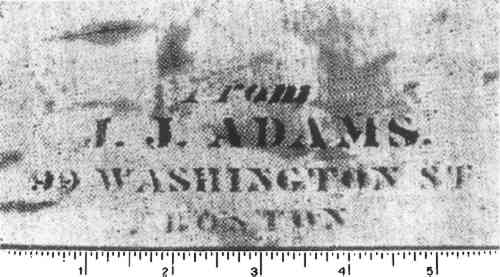 |
Fig. 1b.
Stencil size: 4.1 cm (1–5/8″); Color of Ink: Black; Occurrences: 1. Anon, John Whipple of Beverly off Minot's Light, dated 1851, P.M. Stencil located in corner. 2. Anon, Barth Children, dated 1851. Private collection. 3. Anon, Ship off Minot's Light. Private collection. Pre-primed. Stencil from G. Rowney, 51 Rathbone Place, London, was also noted on the same fabric (Fig. 1b), partially obscured by the stretcher member. Rowney was at this address from 1815–1858. 4. Anon, Samuel Baker Walcott (1795–1854), E.I. Fabric pre-primed. G. Rowney, 51 Rathbone Place, London, stencil was also noted. 5. C. Drew, Ship Witch of the Wave, built 1851. P.M. Also stencil of G. Rowney, 51 Rathbone Place, London. 6. Chester Harding, Portrait of a Woman. M.F.A. Stencil centered.
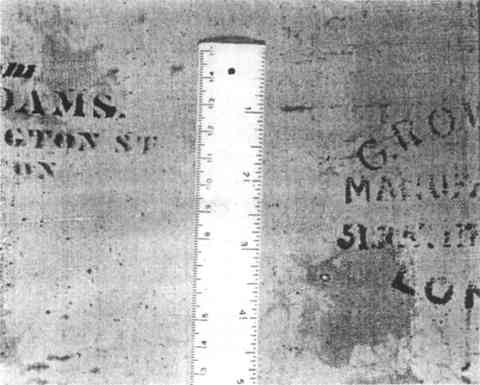 |
Fig. 3.
Stencil Size: 7.0 cm (2–3/4″); Color of Ink: Black; Occurrences: Alvan Clark, Charles H. Cummings, M.F.A. Stencil centered. A Cotton stencil for the 272 Washington St. address was found on Sanford Gifford's Intervale Valley, New Hampshire, Phoenix Art Museum, Phoenix, Arizona.
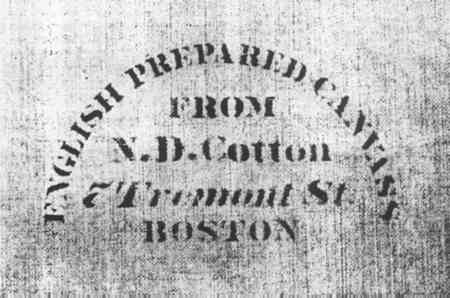 |
Figure 2 shows a double stenciled canvas from Boston. On the left side was the stencil of J. J. Adams and to the right, alongside it, was the stencil of O. Stearns, which read “Prepared by.” Obviously, Stearns prepared the canvas and Adams sold the product. Since the painting presumably bore the date 1846, Adams' stencil would be the first impression he used at 99 Washington Street. Unlike the other stencils Adams used which have the “From” slanted, as shown in Figure 1a, the early example has the letters upright. Stearns' stencil probably dates from his location at 91 Washington Street, only a few doors away from Adams' shop.
Fig. 2.
Occurrences: Combination Adams and O. Stearns stencil on a painting by Thomas H. Hinckley, ca. 1846. Sizes unknown. Courtesy of Carroll Wales, Boston.
 |
The Morris stencils are varied and extremely interesting, as shown in Figures 8 to 12. With the discovery of a new C. A. Morris stencil on a painting in California, as shown in Figure 11, and the identification of the subject,6 the date for this stencil and one previously misinterpreted, as shown in Figure 10, now seems resolved.
Fig. 8.
Stencil Size: 9.7 cm (3–13/16″); Color of Ink: Black; Occurrences: 1. Charles Osgood, William Henry Honeycomb, E.I. Stencil located in corner. 2. Anon, Mrs. Sarah G. Honeycomb, E.I. Stencil in corner. 3. Clement Drew, Unidentified Ship, P.M. 4. C. Drew, Brig Cecelia, P.M. 5. C. Drew, H. H. Cole (built 1843), P.M. 6. R. Salmon (attrib.), U.S. Revenue Cutter Hamilton, P.M. 7. Anon, Ann M. Goodridge, E.I.
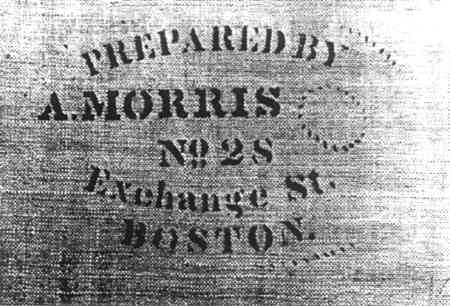 |
Fig. 9.
Stencil Size: 5.0 cm (2″); Color of Ink: Black; Occurrences: C. Drew, Ship Sophia, dated 1846, P.M.
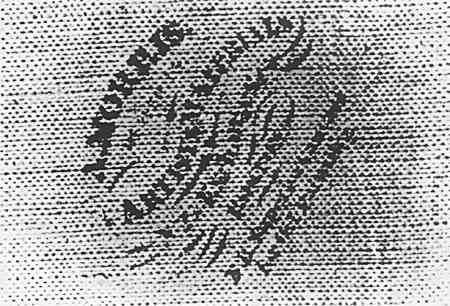 |
Fig. 10.
Stencil Size: 7.0 cm (2–3/4″); Color of Ink: Black; Occurrences: C. Drew, Steamship Seagull (built 1848), P.M. Stencil angled in corner.
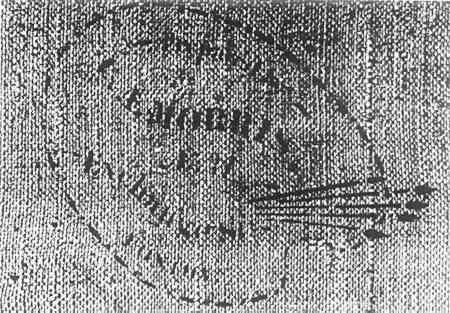 |
Fig. 11.
Stencil Size: 9.7 cm (3–13/16″); Color of Ink: Black; Occurrences: Anon, Arnold Cook Janes, Claremont Colleges Gallery, Pomona, California. Stencil in corner.
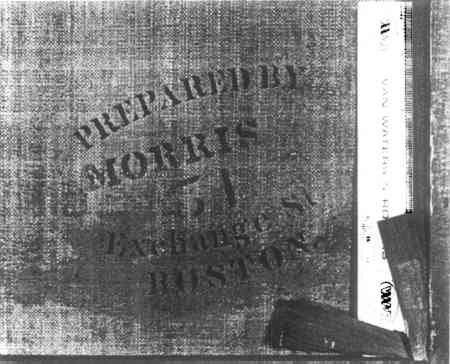 |
Fig. 12.
Stencil Size: 9.7 cm (3–13/16″); Color of Ink: Black; Occurrences: C. Drew, Bark Ionia (built 1847), P.M.
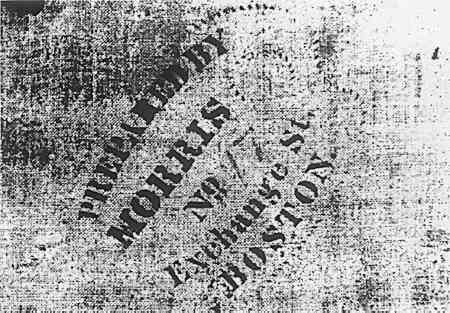 |
It should be observed that reference is often made in the checklist to the positioning of the stencil, color of ink used, and whether the fabric was primed by the preparator. This information, while sketchy now, may have greater significance when other paintings are examined and compared with the data contained herein. It is my feeling that the job of preparing the canvas may often have been delegated to an assistant, and that this individual's feeling for design may be reflected in the position of the stencil in relationship to the stretcher border. Moreover, certain colored inks may have been used in certain years. Most inks were black, but in one instance M. J. Whipple used blue.
In the checklist, the sizes correspond to greatest height. A few abbreviations have also been incorporated. E. I. stands for the Essex Institute, Salem, Mass; M. F. A. for the Museum of Fine Arts, Boston; and P.M. for Peabody Museum, Salem, Mass.
|








